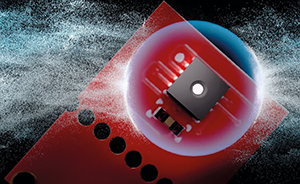

Texas Instruments introduced the first devices in a new family of humidity sensors that provide what the company claims are the industry’s highest reliability and accuracy and the lowest power consumption – along with built-in protection of sensing elements. The HDC3020 and HDC3020-Q1 will allow engineers to create more reliable industrial and automotive systems that withstand potential damage caused by moisture and react as needed to changing water vapour conditions over time.
Moisture affects system performance and product longevity of applications in vehicles, appliances and medical equipment. From extending the life of produce during transport and storage, to keeping automotive cameras clear of fog, to controlling air quality and flow in buildings, the need for improved reliability and safer, more comfortable environments has increased the adoption of relative humidity (RH) sensors.
Offering improved relative humidity measurement accuracy with reduced long-term error, the HDC3020 and HDC3020-Q1 preserve data integrity under stress conditions and are the industry’s first to provide integrated correction to adapt to drift caused by natural ageing, environmental stress or interactions with contaminants.
The HDC3020 and HDC3020-Q1 achieve lower drift in extreme conditions than competing devices, with less than 0,21% RH accuracy drift per year and less than 5% RH drift from temperature and humidity stress (tested up to 85% RH and 85°C). This sustained accuracy enables longer system lifetimes, eliminating the need to frequently replace or recalibrate the sensor.
When exposed to stress or contaminants, the sensors also provide a second line of defence whereby even a small accuracy drift from the sensor’s time-zero specification can be removed using integrated drift correction technology. Low drift is especially important in long-life applications, because it enables better performance and greater reliability over time.
The HDC3020 and HDC3020-Q1 provide high accuracy across the full supply voltage of 1,62 V to 5,5 V and the widest temperature and humidity range at ±1,5% RH. This high accuracy enables more precise control of a system, increasing efficiency by ensuring that the system only runs when necessary.
Additionally, the sensors are available in several pin-to-pin compatible package cover options, such as removable polyimide tape and permanent IP67-rated filter covers. The covers provide ingress protection against dust and moisture for the devices during assembly and over system lifetimes and help maintain accuracy when the sensor is exposed to contaminants.
Ultra-low power consumption (in the nanoampere range) across the full supply range enables low-power operation both while a system is actively running and in sleep mode. An automatic measurement mode enables humidity sensing at regular intervals to capture data while the rest of the system sleeps, further preserving system battery life in applications such as cold-chain data loggers, wirelessly connected environmental sensors such as air quality monitors, smart home or wireless sensor nodes in buildings, or IP network cameras.

© Technews Publishing (Pty) Ltd | All Rights Reserved